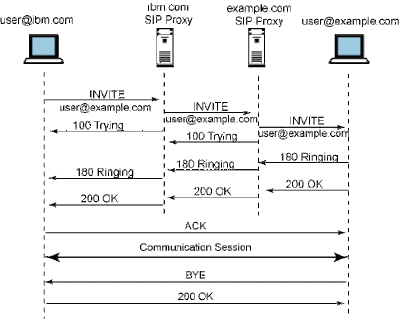Another effort from the my performance team members is documented in the latest IBM press release.
This effort shows how:
- WebSphere Application Server is leading the way in critical new technologies (SIP)
- The WebSphere Application Server has performance that is not only leading, but also carrier-grade while being enterprise capable - including High Availability.
- Our commitment to driving open and trusted industry standard benchmarking
In WebSphere Application Server 6.1, we added support for the IETF Session Initiation Protocol (SIP). SIP is a request/response protocol for negotiating communication between two endpoints that has been widely adopted in the telecommunications industry. SIP is useful in Voice Over IP (VOIP), web click to call, conferencing, interactive voice response systems, instant messaging, and presence applications.
Below is a basic example of a session initiation between two parties. It shows a swim lane diagram of user@ibm.com starting a discussion with user@example.com with proxies inline to negotiate the session.

In the press release, we announce how AT&T plans to use our SIP technology:"AT&T is using IBM WebSphere Application Server and BladeCenter systems as a Session Initiation Protocol (SIP) service logic execution environment platform to develop mission-critical services for deployment on AT&T's IP-based network."
The features needed to support AT&T include not only SIP, but also technology that makes such latency dependent applications such as VOIP possible, along with enterprise class high availability. Also, performance is quite important. Also mentioned in the press release, we detail an internal SIP benchmark we ran along with the results:"IBM's WebSphere Application Server delivers telecom class infrastructures with a focus on SIP features. It is a carrier-grade application server that utilizes a converged HyperText Transfer Protocol (HTTP) and SIP container. It allows service providers to quickly offer new personalized and productivity enhancing services that subscribers demand. WebSphere Application Server 6.1.0.11 using Red Hat Linux and integrated in the IBM BladeCenter HT chassis, which is network equipment building systems (NEBS) compliant, has achieved an industry leading SIP performance measurement of 1296 calls per second, using a 13 message SIP call model (with 80 second hold time) which translates to over 4.6 million busy hour call attempts per blade. Using this call model, in a high availability, carrier-grade configuration, WebSphere Application Server achieved 660 calls per second per blade with session replication. These results were achieved while retaining extremely low end-to-end SIP message processing latency of under 50 milliseconds ninety five percent of the time. This exhibits the ability of WebSphere Application Server to handle the call volumes businesses demands while ensuring service quality."
What does this mean?
It means that our converged web container (supporting typical HTTP servlets, JSR 168 portlets, and now JSR 116 SIP Servlets) can perform SIP operations at carrier class speeds. We demonstrated this using an internally developed SIP call model benchmark. The benchmark is similar to benchmarks being used externally by other SIP platform vendors, but only IBM added high availability to the benchmarking scenario. IBM shows that we lead in performance where it counts – in enterprise ready high availability scenarios.
Based on my previous posts, you would assume we'd want to push SIP benchmarking to standardized benchmarking organizations so the measurements can be trusted by customers. Well, we are doing exactly that! IBM, along with other vendors, has formed a subcommittee at SPEC to develop an industry SIP benchmark. Erich Nahum (IBM) is chairing the group and has requested public feedback on the current proposal.
If you'd like to find out more about SIP, Erik Burckart has a two part article on SIP containing both an introduction to SIP as well as a guide to developing converged SIP applications.
Congrats again to my most excellent performance team members.
Update: Telephony Online coverage that includes comments on SIP performance.